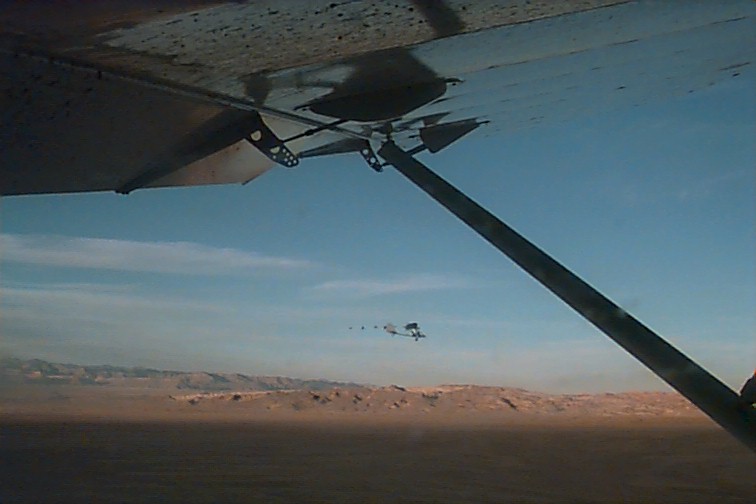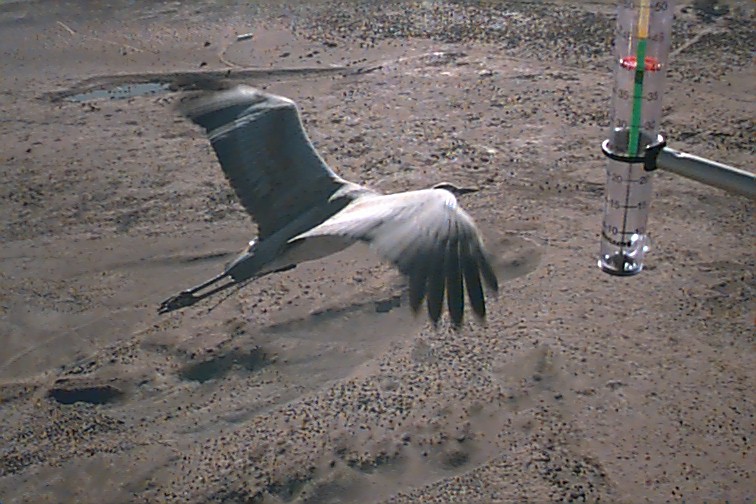
Day One
October 16, 1996

The sun line crept towards the eastern edge of the valley bringing with it the warmth and brilliant light of morning. Kent taxied his plane uphill towards the crane pen and idled to a stop. As he walked towards the gate, the seven cranes had heads cocked in his direction - anticipating the routine morning flight but unaware that they were about to embark on the biggest adventure of their young lives.
Out of the pen, they didn’t even wait for their leader before taking to the air. Kent raced for the plane to catch up before they circled and landed. In a few seconds, plane and cranes were grouped together in the air and headed out over the shop and farmhouse. The 1996 migration had begun!
Weather on this bright Wednesday morning is spectacular. Cool, cloudless, and brilliantly sunny. During the night, a light storm had dusted the mountain tops with a powder of snow. The fields are golden with stubble or rich brown from freshly worked soil. Here and there are fields of green with alfalfa that is newly started. The river is still and smooth and lined with dried reeds and rushes.
The flight began with seven sandhills grouped closely around the plane. As they traveled down through Gem Valley and into Mound Valley they gradually settled into a V-pattern with four birds on one wing and three on the other. As they started up through Cleveland the wind was blowing stiff over Treasureton summit. Standing on the ridge I could see the plane being buffeted up and down by the air currents. The engine labored to maintain altitude and the birds were pumping vigorously to stay up. Their orderly pattern dissolved as they struggled to keep together.
Once over the pass there was some lift coming off the hills to the east and the group was able to gain some altitude. As they flew on towards the reservoir, one of the birds was lagging behind. It was the one that had rudder problems, number 107. During the summer, with the series of examinations and shots, 107 had developed a nerve problem with one of its legs. When she flies, her leg hangs down just like a rudder in the water.
The open area gave 107 a chance to catch up as they worked their way out past the power substation and towards the Riverdale canyon area. Air conditions were such that it was difficult to gain altitude. As I climbed Riverdale hill in the chase vehicle, the plane was flying so low that I lost site of the entourage. I dropped down the hill towards the golf course, cut into someone’s hayfield and raced to the top of the ridge. Coming towards me, just skimming the hilltops was the Dragonfly plane and the sandhills.
As we headed out west of Preston, 107 started to fall behind again. I stayed behind with her as the rest of the pack moved ahead. Kent was debating whether to set down somewhere or keep moving. The six birds that were around the plane were flying strong, the weather was good, and the path ahead was clear so they kept going.
107 was pumping for all she was worth but was having trouble staying on course. She veered to the west, far to the east and then gradually started a long glide towards the river gully. I marked the approximate spot of the last sighting and then accelerated to catch up.
It was an all out race to keep Kent in sight. Farm roads through Cache Valley primarily run on a north/south grid system and don’t follow the way the sandhill flies. Roads changed from paved to gravel to potholes in a few places and I had to dodge and weave to keep up.
The last crackling radio transmission was something about ‘setting down’. As I raced towards Lewiston, Utah, Errol was giving me directions as to where Kent had landed. "They’re behind the three tall dark silos and four small ones." he said.
About half a mile east of downtown Lewiston in the middle of a dairy farm there happened to be a landing strip - complete with windsock, hanger, and orange obstacle marker balls hanging from the power lines. The grass strip was bordered by hay on one side and a line of wheelmoves in barley on the other. Errol’s bright red and white chase plane wasn’t far behind.
It took about 45 seconds for someone from the farm to join us. Val Gunnel was his name. "Welcome to the Ray Gilbert International Airport!" he said. "I thought maybe it was that girl takin the geese back from Canada." Within a few minutes, several more hands from the farm had joined us including Ray, the owner of the property and the Cessna 206 hangered in the shed.
We set up pens and Kent called the birds inside while Errol and I herded them from behind. With the planes staked down and Jim standing guard, we piled in the Suburban with Ron and Sherm (the CBS camera guys) and headed back north to find the downed bird using radio signals.
Each bird is fitted with a solar powered radio transmitter that emits a signal on a different frequency for each bird. The Suburban has a unidirectional antenna mounted on the roof. This is used for determining if we were getting generally closer. Once a signal was heard, we switched to the hand held directional antenna to pinpoint more closely where the bird might be. We took two readings in different locations to get a rough crossing point for the directional vectors. It looked like 107 may be somewhere in the vicinity of the old sugar beet processing factory.
As we pulled onto the main highway and headed north the signal was very strong. Kent’s sharp eye spotted her off to the north in a corn field near Benson. With all the dried corn left over from the harvest, she was strolling and feasting. We parked the truck and Kent walked towards her making his daddy crane warble. Her head perked in his direction and then she walked straight towards him. He held her by the wings and legs and we drove the 8 miles back to join her with the rest of the flock.
Lunch time at J&B’s in Richmond for a round of hamburgers and a lime freeze. The afternoon was spent chasing spark plugs, getting fuel, and napping in the vehicles trying to stay out of the increasingly chilling wind. Ron and Sherm continued work on the cameras mounted on the plane. Over lunch we previewed some of the footage and found there was a vibration that distorted some of the picture.
The temperature dropped and the winds picked up as the afternoon wore on. Estimated time of departure was 5 p.m. but as the hour came and went, the winds didn’t die down at all. At about 6 p.m., we climbed out of the trucks and started to wrap the planes in canvas so that they would be protected from frost. As the sun set, one large puffy reddish orange cloud hung in the sky. Tomorrow’s forecast looks better with less chance of moisture and calmer winds.

